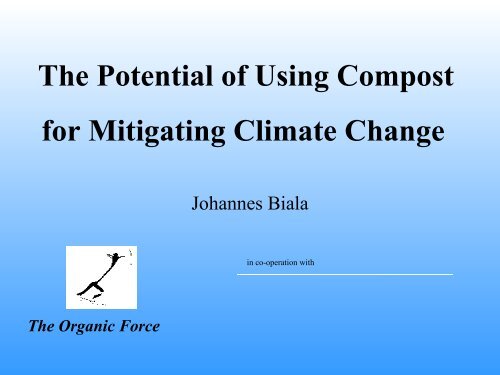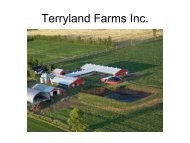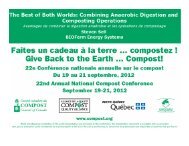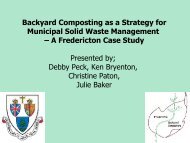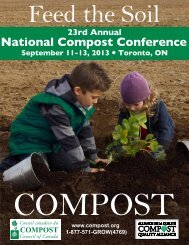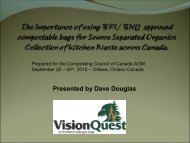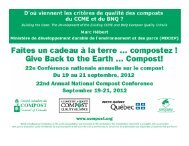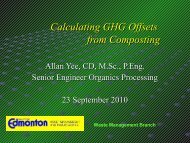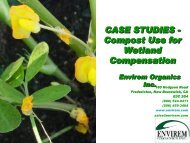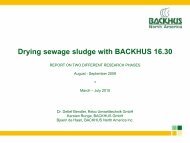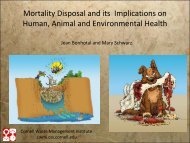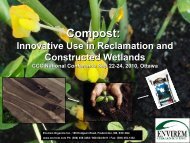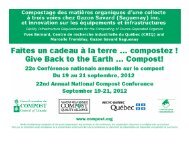Johannes Biala, The Organic Force - Compost Council of Canada
Johannes Biala, The Organic Force - Compost Council of Canada
Johannes Biala, The Organic Force - Compost Council of Canada
You also want an ePaper? Increase the reach of your titles
YUMPU automatically turns print PDFs into web optimized ePapers that Google loves.
Potential KeyMitigation Measures1. Enhancing removal <strong>of</strong> atmospheric carbon- Soil carbon sequestration2. Reducing emissions- N 2 O emissions from soil- Methane emissions from soil- GHG emissions from fertiliser production
<strong>Compost</strong>ing –Loss <strong>of</strong> Carbon<strong>Compost</strong>ing <strong>of</strong> manure solidsSource: Inbar et al. 1989 in Epstein 1997
<strong>Compost</strong>ing –Building Stable <strong>Organic</strong>Compounds<strong>Organic</strong> ResiduesTotal <strong>Organic</strong> C(% DM)‘Recalcitrant’Lignin C(% <strong>of</strong> TOC)‘ReadilyDecomposable’ C(% <strong>of</strong> TOC)Farm manures 32 30 70Paper mill sludge 30 20 80Garden organicscompost13 65 35Source: Bhogal et al. 2007
<strong>Compost</strong> Use –Carbon Transformation ContinuesDecomposition <strong>of</strong> composted and uncomposted organic amendmentsExamples Carbon Transformation5.7% TOC in 70 d – tree prunings + yeast composted 25 wks21% TOC in 32 wks – two-phase olive waste composted 34 wks14% TOC in 24 wks – 20 samples <strong>of</strong> manure + plant based composts5% TOC in 60 d – MSW + biosolids compost in 2 soils8% / 14% TOC in 60d – biosolids compost in 2 soils17% TOC in 52 wks – biowaste in mine site rehabilitationLabile organic compounds are degradedSource: Gale et al. 2006
<strong>Compost</strong> Use – Carbon SequestrationUse Use <strong>of</strong> <strong>of</strong> garden & food organics compost at in 55 sites fields over / 2 9 farms / 12 yrs inUK(relative compared to control)<strong>Compost</strong> application (t DM ha -1 yr -1 )Sites with silageAll locationsSource: Davison 2008Source: LTZ 2008<strong>Organic</strong> matter (%)
<strong>Compost</strong> Use - Carbon SequestrationCarbon Sequestration (12 yrs)Increase soil organic matter level (percentage-point)50% TOC - Mature garden organics compost (Site: Trend We)46% TOC – Mature garden + food organics compost (Site: Fo)30% TOC – Pasteurised garden + food organics compost (Site: St)Carbon Addition per 10 t DM ha -1 (avg over 12 yrs)0.82 t C ha -1 yr -1 - Mature garden organics compost0.97 t C ha -1 yr -1 – Mature garden + food organics compost1.13 t C ha -1 yr -1 – Pasteurised garden + food organics compostFor maintaining SOC levels<strong>Organic</strong> matter increasey = 0.012 x OMR 2 = 0.434.8 t DM ha -1 yr -1 - Mature garden organics compost3.8 t DM ha -1 yr -1 – Mature garden + food organics compost2.6 t DM ha -1 yr -1 – Pasteurised garden + food organics compostSource: LTZ 2008Addition <strong>of</strong> compost organic matter (t DM ha -1 )i.e. 8 - 9 t DM ha -1 yr -1= SOM increase by 0.1%
<strong>Compost</strong> Use - Carbon SequestrationPotential SOC increases in UKdue to use <strong>of</strong> organic soil amendments for up to 20 years (Model)<strong>Organic</strong> AmendmentCereal strawIncrease in SOC(kg ha -1 yr -1 t -1 DM applied)50 (20 – 80)C Retained in Topsoil(% <strong>of</strong> applied C)7Manures(and paper sludge)60 (20 – 100)23Biosolids- Digested- Raw180 (130 – 230)130 (90 – 170)5636Garden organics compost60 (40 – 80)43Source: Bhogal et al. 2007
A Simple<strong>Compost</strong> Carbon Sequestration ModelSoil organic matter (%)Source: Favoino & Hogg 2008
<strong>Compost</strong> Use - Carbon SequestrationLong-term & Medium-term Carbon Storage is Important• Assumptions:- Mature garden organics compost- 20 years: 45% compost C sequestered- 50 years: 35% compost C sequestered- 100 years: 10% compost C sequestered• Sequestration:Mature garden organics compost at a rate <strong>of</strong> 10 t DM ha -1will sequester carbon that is equivalent to• 5,046 kg CO 2-e over 20 years• 3,532 kg CO 2-e over 50 years• 1,009 kg CO 2-e over 100 years
<strong>Compost</strong> Use – Reducing Emissions• N 2 O emissions from soilEffects <strong>of</strong> compost use unclear• Methane emissions from soilGenerally not a problemEffects <strong>of</strong> compost use unclear• GHG emissions from fertiliser production- Fertiliser replacement potential <strong>of</strong> compost- Nitrogen mineralisation and plant uptake- Nutrient (P & K) use efficiency
Nitrogen Mineralisation<strong>Compost</strong> / AmendmentType, QuantityCattle manureCattle manure compostManure compost60 t ha -1Durationweeks52Net Mineralisation% <strong>of</strong> N tot or N org12 – 28 (avg 21)N org8 – 12 (avg 11) N org25% N tot34% N totFour manure composts 16 0 - 14% N totManure compost 3211 - 29% N tot
Nitrogen Mineralisation- Generalisations -• Immature compost- temporary nitrogen immobilisation- total nitrogen mineralisation is <strong>of</strong>ten lower than frommature compost (in the short term)• <strong>Compost</strong>ing <strong>of</strong> manure results in markedly reducednitrogen mineralisation• Mineralisation rates range between 5% and 20% <strong>of</strong> addedtotal nitrogen in the most favourable temperature andmoisture conditions• Mineralisation rates are higher in sandy soils than in claysoils
Nitrogen Mineralisation- Mature & Immature <strong>Compost</strong> -Fresh <strong>Compost</strong>Mature <strong>Compost</strong>Cumulative NO3 release as % <strong>of</strong> initial N in compostSource: Chodak et al. 2001DaysDays
Type <strong>of</strong> <strong>Compost</strong>Plant Available Nitrogen (% <strong>of</strong> total N added)NitrogenUse EfficiencySource: Amlinger et al. 20031 st Year 2 nd Year 3 rd Year SubsequentGeneric compost 10 2 - 3 2 - 3 2 - 3Generic compost10 (spring)15 (autumn)Generic compost 10Generic compost < 10Generic compostVarious compostsVarious compostsPot trial0 - 10Field trialFYM compost 11Biowaste compost 1 - 25Biowaste compost 7Biowaste compost 5 - 7Biowaste compost < 52 – 5 2 – 53.5 3.5Total <strong>of</strong> 12% – 20% after eight yearsTrial 1: 2 – 7Trial 2: 1 – 8-19 - +4 (0) -17 - +17 (-3)2 – 53.5Biowaste compost 10 - 150 – 3 (short termBiowaste compost5 – 8 (medium term)> 8 – 10 (long term)Biowaste compost0.3 – 14average over 6 years with annual applications (total average = 7%)Biowaste compost7 – 34 ^Biowaste compost0 – 12.6(avg = 6.1%) ^^Garden organics compost 5 - 10MSW compost 8 5 3 1.5MSW compost 5.3 – 13.2
Nitrogen Use Efficiency• Generally: 5 – 10% uptake <strong>of</strong> added N• < 5% during initial 3 - 4 yrs• 5 – 15% if compost applied > 4 yrs• N use efficiency higher (5 – 25%) if no / littleuse <strong>of</strong> mineral N• N use efficiency higher if used for crops withhigh N demand
Nitrogen Use Efficiency12 yrs = 4 cropping cycles5 t DM ha -1 10 t DM ha -1 20 t DM ha -1n noitropor PCropping cycle (3 yrs each)0% min NegortiSource: Haber et al. 2008
Nitrogen Accumulation & Releaseos det al u mucc AN mineralisation from compost (kg/ha)Application: 8 t DM ha -1 yr -1N content: 1.6% DMN mineralisation: 1. year = 10%; 2. year = 4%; subsequent = 2%YearsYearsnliSource: Amlinger et al. 2003rti
Nutrient & Carbon Content (kg/t DM)<strong>Compost</strong> Type(Source)Garden organics(Wilkinson et al. 2000)Garden organicsGarden organics blended(Chan et al. 2007)Garden organics blended(Paulin et al. 2005)Garden organics(Bhogal et al. 2007)*Biowaste & garden organics(BGK 2009)Biowaste(Linzner et al. 2005)CountryNo <strong>of</strong>SamplesNitrogen(N)Phosphorous(P)Potassium(K)Carbon(C)Australia 33 - 47 8.80 1.80 5.33 324Australia(Sydneyregion)Australia(Perth)UnitedKingdom101210.0012.101.603.805.004.4025120618 - 21 14.30 7.69 5.81 306?Typical10.70 1.88 6.77 214Germany 5,422 14.00 2.92 9.63 225Austria(Vienna)Average**2001-03Nutrient & carbon concentration, as well as fertiliserreplacement rate (% <strong>of</strong> total) used for calculations17.80 2.92 10.54 24411.00(40%)2.00(100%)5.50(100%)275
GHG Emissions Fertiliser ProductionType <strong>of</strong> Fertiliser Specification Emissions(kg CO 2 -e t -1 nutrient)Nitrogen FertiliserAmmoniaEurope 1,402 – 2,638<strong>Canada</strong> & USA 1,492 – 1,951Ammonium NitrateCalcium Ammonium NitrateUreaUrea Ammonium NitratePhosphorous FertiliserSingle SuperphosphateTriple SuperphosphateAustralia 1,524 – 2,195Europe - average 6,537 – 7,109Europe – modern technology 2,985Europe - average 6,810 – 9,563Europe – modern technology 3,019Europe - average 1,326 – 4,019Europe – modern technology 913Europe - average 3,668 – 5,763Europe – modern technology 2,000Europe - average 41 – 459Europe – modern technology -104Europe - average 154 – 473Europe – modern technology -182
GHG Emission Savings fromFertiliser ReplacementNutrientelementNutrientcontent(kg t -1 DM)Crop uptakeFertilisernutrientsreplaced(kg t -1 DM)Fertiliser GHGemissions(kg CO2-e t -1 )Avoided GHGemissions(kg CO2-e t -1DM compost)Garden organics compostNitrogen (N) 11 40% 4.4 3,500 15.4Phosphorous (P) 2 100% 2.0 350 0.7Potassium (K) 5.5 100% 5.5 300 1.7Total 17.8
Potential GHG Mitigationthrough <strong>Compost</strong> Use• Assumption:continuous use <strong>of</strong> 10 t DM ha -1 mature gardenorganics compost• Sequestration:Time frameGHG mitigation (kg CO 2 -e)Soil carbon sequestration Fertiliser replacement Combined20 years 5,046 178 5,22450 years 3,532 178 3,710100 years 1,009 178 1,187
Having these largelyEuropean-based Datais Good,but not Good Enoughto Make a Difference in Australia1. Adjust data to reflect Australian conditions2. Incorporate compost use into AustralianNational Carbon Accounting System (NCAS)3. Introduce the concept and use <strong>of</strong>‘Humus Budget’
Introducing ‘Humus Budget’as Soil & Farm Management ToolHumus loss Humus replenishment Humus budget+ = Re-branding away from ‘carbon’ Potential to link with farm nutrient budgetsSource: Siebert, 2008
Example <strong>of</strong>Humus Budget for Crop RotationCropSugar beetWinter wheatWinter wheatTotalkg Humus-C / ha-760 to -1,300 kg-280 to -400 kg-280 to -400 kg-1,320 to - 2,100 kgImports<strong>Compost</strong> (25 t DM in 3 yr)Balance (3 years)2,600 kg500 - 1,280 kgSource: Siebert, 2008
- Summary –<strong>Compost</strong> Use …• won’t save the world, but….• Can contribute to mitigating climate change• Can help open a window <strong>of</strong> opportunity (20 – 30years) to find other means (technologies) <strong>of</strong>reducing / mitigating emissions• Is one <strong>of</strong> the fastest means <strong>of</strong> improving soilcarbon levels• Is ideally suited as mitigation measure inproductive agricultural soils• Fits easily into Australian NCAS• Can attract carbon credits
Never Forget:<strong>Compost</strong> is much more than Carbon!SoilCarbonSoil QualityAggregation &InfiltrationWater &NutrientHoldingProductivityAir & WaterQuality;Wildlife HabitatSource: USDA NRCSTime
www.compost-for-horticulture.com


